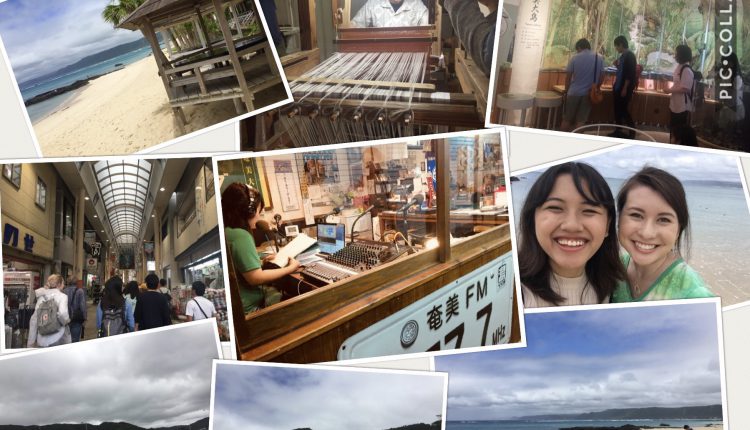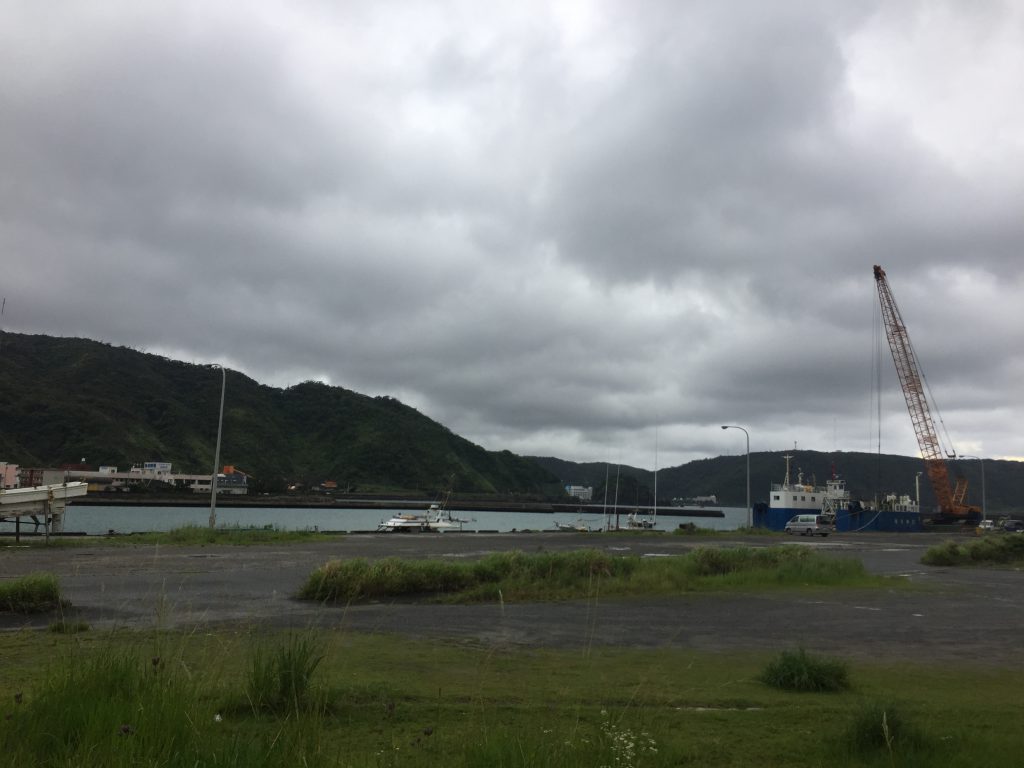
Balinese EndekIn the 21st century, amidst the still rapid advancement of technology, there are many on going talks on how to preserve the current nature. Following the UN Sustainable Development Goals Summit in China, which marked the beginning of nations commitment to cut down emissions and start placing more concern on nature, how nature faces the current challenges posed by the advancement of technology, and how culture can survive the threat of extinction in today’s fast advancing world, are relevant topics of today’s world. There is no better way than to understand them than experiencing the real world example. I, along with the rest of the class were given the opportunity to experience the place in which two
of (nature and culture) co-exist together in Japan, which is Kamakura and Amami Oshima. While Kamakura was a preparation trip for us, Amami Oshima was our main case study. In this essay, I will focus on the activities I did in Amami Oshima, referencing and comparing them with my hometown Bali, Indonesia and how, at the end of the day, all of them taught me a very valuable lesson. The essay will begin with the reflection of activities, lectures in Amami Oshima, divided into two parts: Culture, Nature, how both coexist together; then followed with a comparison analysis of Amami Oshima and Bali on different aspects, the challenges for Amami Oshima; and finally closed with a conclusion for the last paragpraph.
Culture
Amami Oshima has their own culture, one that is very different from the rest of Japan. During the 3 day trip I was able to enjoy various cultures, mainly the ooshima tsumugi textile and the Ugami Shora (their traditional song).
1. Ooshima Tsumugi Textile
On the second day we went to Ooshima Tsumugi textile making house, where we were able to see the process of making ooshima tsumugi from scratch to the finished cloth. Ooshima Tsumugi is a woven cloth textile The process takes a long time and careful waving. First, the thread are dyed using mud, and dried. Then, the thread are carefully woven by several people working in the house. Using different colors, they make a pattern on the cloth, and after that goes back and fixes if there were any wrong thread. This process could take months, and that is why the cloth is very important and expensive. Seeing the ooshima tsumugi reminds me of similar textile making process in Bali– which I will talk more in the last section. It was obvious that they take their jobs seriously, and the importance of this textile.
The biggest challenge for the people of Amami is to preserve the culture of traditional ooshima tsumugi making in the next generations to come. Will the children of next generation want to learn and continue make the textile after they grow up?
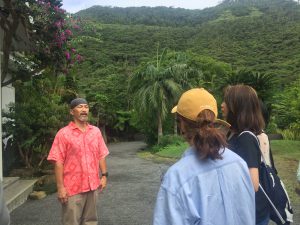
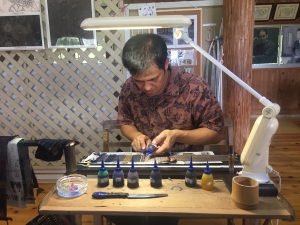
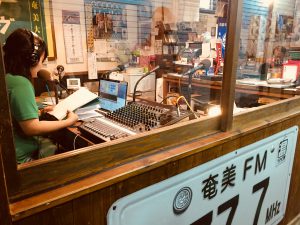
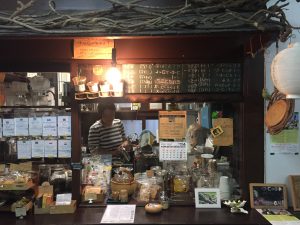
2. Shima Uta/ Island Song
On our last day, after playing in the beach, we had lunch whilst watching two people perform the Amami traditional song for us in private. The theme of the song have deep meanings; about respect to parents, about respect to the culture, etc. The performance was very beautiful, and we danced around to the song. What struck me was that they were genuinely happy whilst singing, joy and peace etched deeply on their faces. It is a true expression of moral lesson from two Amami people whom respected their culture immensely. Later after I came back to Tokyo, I found their YouTube videos here
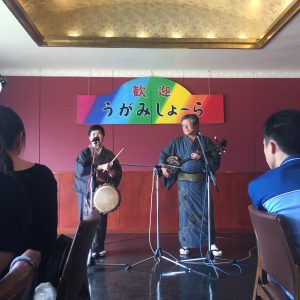
3. People
What struck me was how all the people in Amami were very, very warm and kind. It was different from the people in Tokyo, where everyone is so caught up in their own business. The kindness of people touched me. It was Islanders, the warm climate and slower pace of life that made them more thoughtful of others. We came as strangers, but were never treated like one. They happily took their time and talked to us whenever we interviewed them&/ or asked them questions about their culture. During interviewing the Amami FM Radio in the market on our second day, the lady I was interviewing even offered me to appear and talk on the radio. It was just unthinkable for something like that to happen in Tokyo. The people of Amami still have that genuine kindness to help everyone, even strangers.
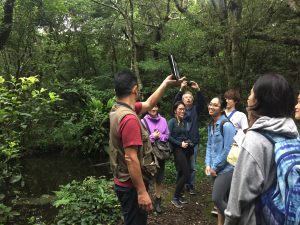
Nature
From the airport we went straight to Amami Wildlife Center, where we listened to three lectures, one from Mongoose Buster,one from the Amami office, and one from a researcher who is researching about the impact of cats in Amami.
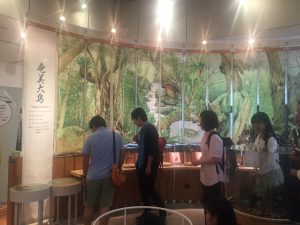
1. Mongoose
The story of how Mongoose came to Amami fascinated the most. Mongoose were brought to Amami in 1979, in an attempt to reduce the number of Habu (poisonous snakes) in Amami. They were hoping that Mongoose would kill the Habu. They brought around 30 Mongooses. However, the result backfired. It turned out that Mongooses are only active at night, so they couldn’t kill the Habu. Even worse, the mongooses presence started to bring negative impact to the ecological balance in Amami.
Beginning in 2005, a serious effort to begin eradicate Mongoose was created. It was called the Mongoose Busters. The Mongoose Busters are a group of people to catch and eradicate the Mongoose. Using different methods, such as using hunter dogs, infrared cameras to detect the mongoose in deep dark forests. The hunter dogs help sniff and detect the mongoose in between trees, and the infrared cameras detect mongoose when they are passing by and help them count the number of mongooose lfeft in certain areas. The extensive effort proved to be succesful. The results were incredible. They were succesful to bring down the population of Mongoose from 10,000 to 50. However, they said they would not stop until all the mongoose are succesfully eradicated from Amami Oshima. The Mongoose case made me realize that the effort to bring in a new animal to solve the ecology problem, can be disastrous if not thought out carefully.
2. Mangrove
The mangroves in Amami are the second largest mangrove forest in Japan after that on Iriomote Island in Okinawa. Most of mangrove forest in Amami offer kayaking for tourists to enjoy the mangroves themselves. We went canoeing in the mangroves. Eventhough it was raining when we were canoeing, thus making the water current hard to naviagate the canoe, I enjoyed the activity immensely.
3. Beach
The beach was definitely the highlight of the trip for me. Throughout the trip, it was always raining most of the time, and I thought I woudln’t be able to enjoy the pretty beach because of the terrible weather, but somehow the sky cleared up right on time. Unlike the beach in Kamakura, the beach in Amami was very clean, no trash in sight. It reminded me of the beach in Bali (which I will talk about in the next section). However unlike beaches in Bali, it was still free from overcrowding of tourists.
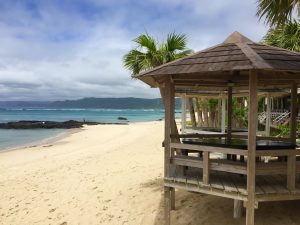
4. Wildlife (Forest)
On the second day, in a terrible weather stormy, rainy, with very strong wind, we left canoe place and headed for the forest. We were originally were going to Kinsakubaru forest, but due to an erosion, the roads were closed down. Therefore we went to a different forest. We had a guide who explained the different animals and plants in the forest. He was using an iPad to help explain the different living things, such as showing pictures and playing the sounds of the animals.
Nature and Culture
There were many touch points were the nature and culture coexist in Amami. For instance, the Ooshima textile making culture uses the natural ingredients. The ingredients came from nature, carefully woven by the people, and worn by the people in Amami for special occassions. This is an act of respecting both nature and culture. The takeaway is, that doing the culture whilst still respecting the nature.
Comparison with Bali
All throughout my time in Amami, there was a lot of moments where it reminded me of my own hometown, Bali, Indonesia. It came as no surprise, because Bali has a lot of similarities with Amami Oshima. Both are islands separate from the main lain of their countries, and located in a fairly tropical climate (though more in Bali than in Amami) blesses both islands with stunning nature. Also, there was this culture of ‘Islanders’ that makes them different than the rest, how Amami people are very prideful of being ‘Amami Islanders’ and similarly, Bali being ‘Balinese’. Both are also prideful of their culture, Balinese with their dances, Amami with their textile, and so on. Therefore, they also face similar challenges– the dillemma of development vs tourism vs nature preservation–eventhough the challenges came to Bali earlier than Amami.
Textile – Ooshima Tsumugi and Balinese Endek
Balinese Endek and Ooshima Tsumugi are both plain woven textile. However, while I get sense of Ooshima Tsumugi being treated as a important cloth, to be worn only in special occassions such as weddings, the government encourages the Balinese to wear Endek as often as possible. They wanted the Balinese to wear it in everyday life. So, in Bali, in most schools, the students are required to wear Endek shirts as their school uniform and politicians wear endek in every single formal meetings. This way, every Balinese are still very knowledgeable about Endek and encourages the Endek textile business. This would prevent the textile culture eroding. Maybe Amami Oshima can use this as reference and follow the similar path in Amami. In this case, I feel like Balinese is doing a better job in preserving Endek textile.
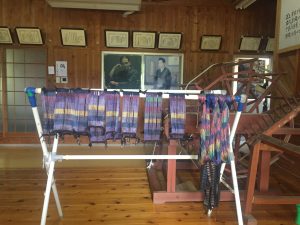
Beaches
Both Bali and Amami have beautiful beaches, mountains. The beaches are pretty, with vast white sand stretching out for miles, bordering the city and the blue ocean. The color of the sea is transparent coral blue, rarely tainted with trash, unlike the beaches in Kamakura. However, beaches in Bali are more developed and has been modified to appeal to the tourists. For example, there are many marine sports options available in the beaches for tourists. Glass bottom boat tours, yacht, cruises options too. On the beaches, there are many restaurants with beanbags, so tourists can enjoy the sunset while dining; There are many surfboard rentals, beach umbrella rentals, massages services, temporary tattoo services and many others to satisfy the needs of touritsts.

These businesses are not available yet in Amami Oshima beaches.
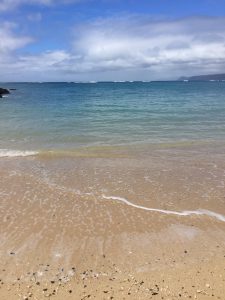
Mangroves: Bali also has an abundance of Mangroves. The mangrove forest in Bali was established with the ODA (Official Development Assistance) donations of JICA (JICA) to preserve the nature of Bali. They play an important part when extreme weather conditions. They act as physical barrier, absorbing the energy and lessening the impact of flood and tsunami.
Challenges for Amami
Looking at Bali, Bali is very beatufiul and has all the things Amami has, yet the difference is that Bali is a overcrwoded spot. It was opened up, discovered a long time ago, and tourism flourished since. Bali’s tourism started developing in 1960s, with the help of Japan, they created Bali Beach Hotel. It was, and to this day still is the tallest building in Bali. Then, the development began, especially in the Southern part. There were constructions of hotels everywhere in Kuta beach and Sanur beach. In Nusa Dua, a special region only for hotels and shops were created. This development resulted from hopes of tourism industry boom. 50 years later, Bali has become one of the world’s attractive tourism area. Though there was a decline in 1998 and 2002 due to Bali Bombings, the number of tourists are still growing each year. It has been a long time since tourism started in Bali, and the impacts cannot be ignored and undone. it is irrevocable. The beaches are overcrowded with tourists, there are lots of rubbish in the ocean, and the culture is in danger of extinction. In my opinion, Bali has not done a good job in balancing the tourists flood and preserving its nature. While Amami would be Bali in 1960s. It was just starting its tourism industry. I hope Amami doesn’t become like Bali, and can handle the tourism flood better. As Okinawa gets more developed, people will start to search for ‘new’ places, and Amami will be one on top of the list. Tourism will bring more pressure to develop the city. The challenge is how the government can balance the development of Amami, make sure the culture is passed on to the next generation, and nature is not eroded.
There were several things Balinese government have done that slowed down the negative impacts of tourism in Bali, such as creating building regulations and strong preservation of culture & religion. In Bali, after Bali Beach hotel was built, there was a concern on how high-rise skyscraper buildings will lessen the beauty of Bali’s nature. The Balinese government then created a regulation which states that no building can be taller than 15 meters– the height of coconut trees. The exception being Bali Beach, which was built before the law was passed. This helped Bali to preserve its nature, as there’s no skyscrapers that could ruin the nature. This regulation proved to be succesful. Maybe Amami Oshima can follow suit, and the government can pass laws which would slow down the rapid development and preserve nature. Also, in Bali, the strong religion and culture of Balinese helped prevent Bali from becoming empty tourism business place. The Hinduism– Balinese religion, which developed from Hinduism from India and mixed with the culture of Bali is only unique to Bali. Even today, the unique Hindu religion is still strongly preserved, safe and strong against the flow of technology. Tourists not only come to Bali to enjoy the nature, but also to enjoy the religious traditions.
Conclusion
Amami Ooshima is facing some challenges they are currently trying to solve: the Mongoose problem, the cats problem, and the sustainability of their culture amongst many others. They are opening up and encouraging tourism, but still at the same time want to preserve the nature. Overall, I definitely felt that the trip to Amami Oshima did very impact on myself and taught me alot. I’m so used of living in a city life, paying no attention to nature and culture. It taught me the importance of preserving the culture and saving the environment. The class trip was a good balance of both learning about the issues in Amami, and enjoying, experiencing (canoeing, swimming in the beach) and merely enjoying the beautiful scenery of Amami.

